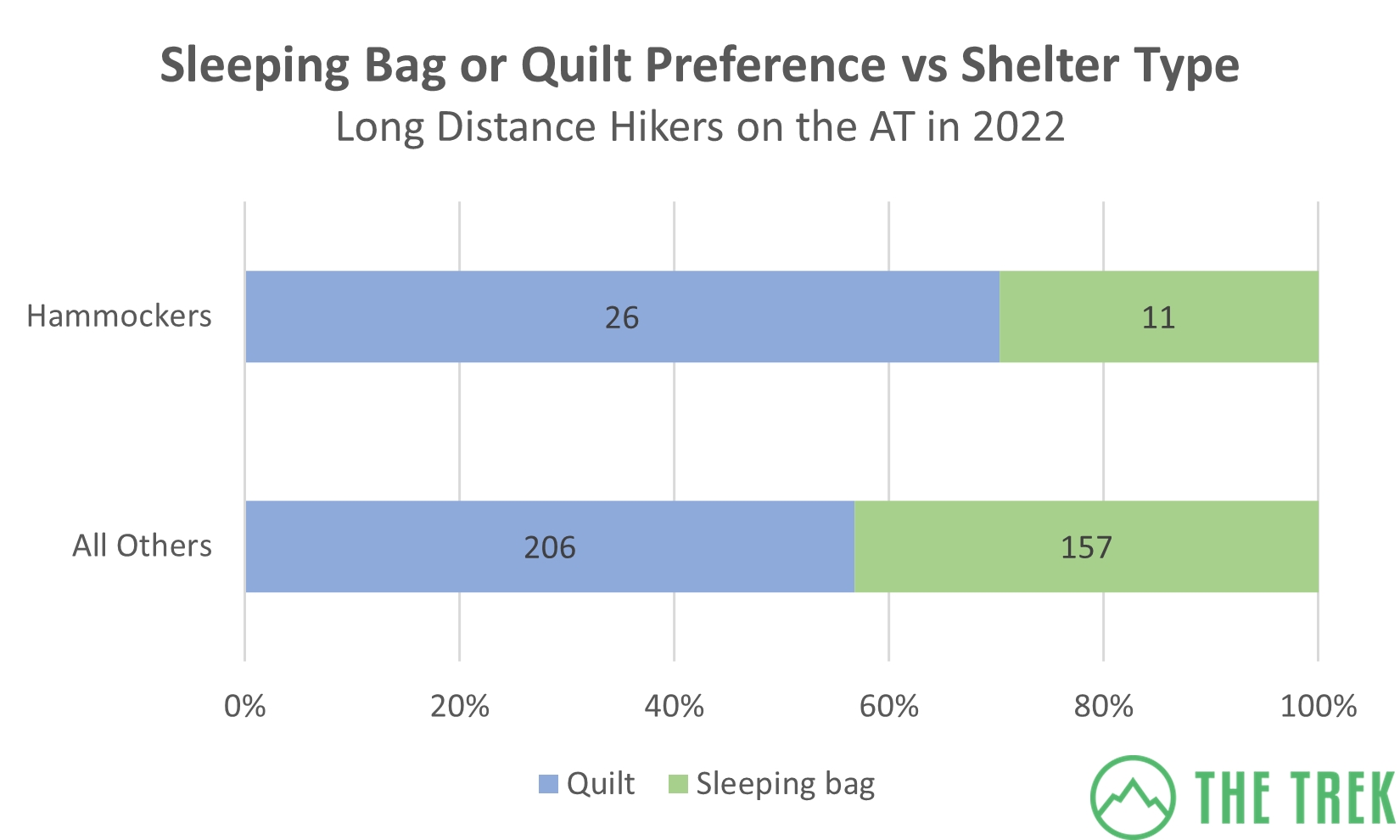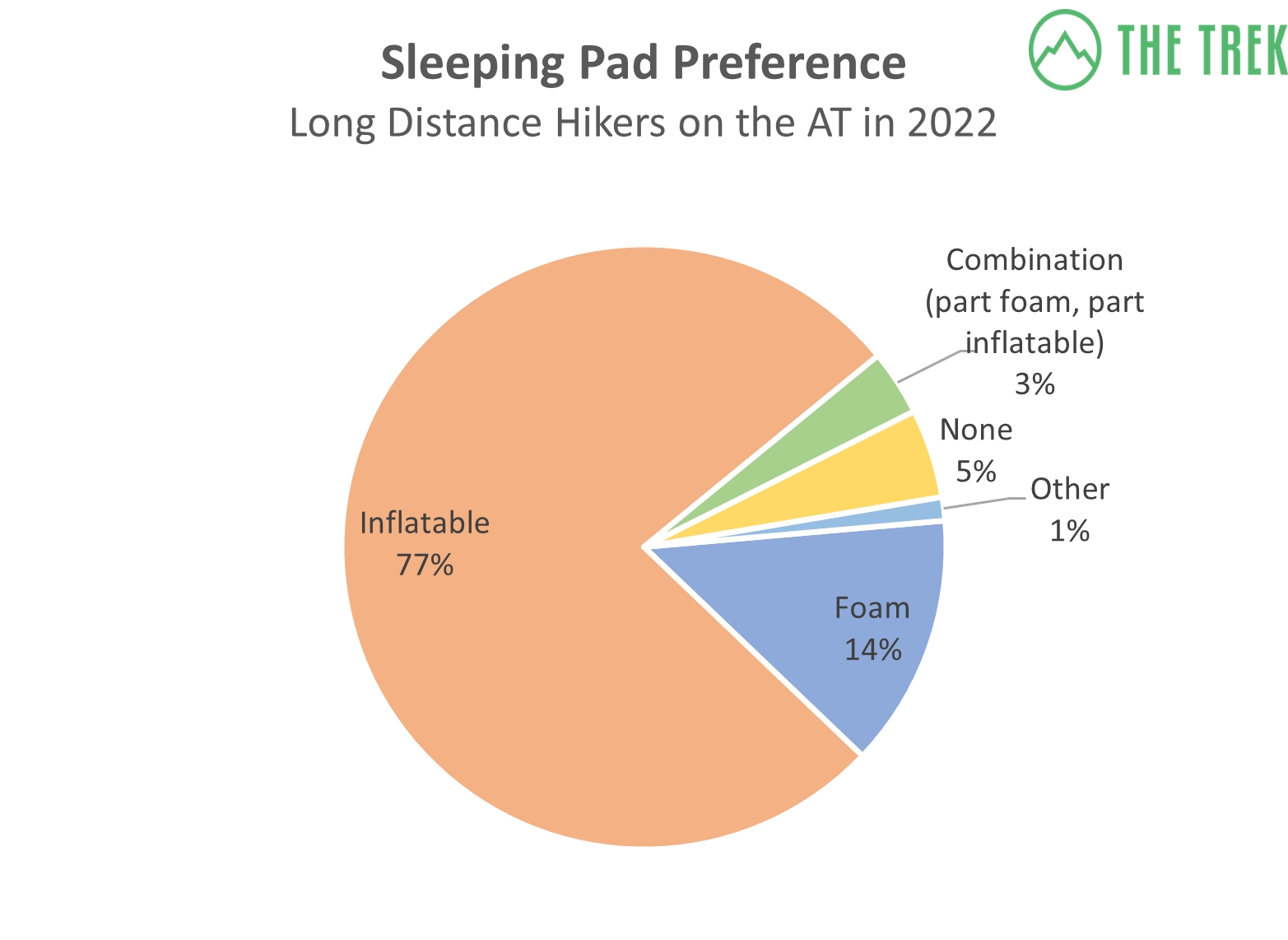The Top Sleeping Bags, Quilts, and Pads on the Appalachian Trail: 2022 Thru-Hiker Survey
Each year here at The Trek, we ask long-distance hikers on the Appalachian Trail (AT) about the sleeping systems they used on their 2022 thru-hike. This post will cover the sleeping systems used, how these systems have changed over time, temperature and insulation type, and the most popular sleeping bags, quilts, and pads from this year’s survey.
The Hiker Sample
In 2022, 403 hikers participated in the survey, all of whom hiked on the AT in 2022. Almost 90 percent were thru-hikers, and the rest were section hikers. For more details on hiker demographics, check out our first post with general information from the survey.
The data were collected from October through November 2022 via our social media platforms, Backpacker Radio, and TheTrek.co. Some clean-up of the data was done only when necessary, mostly involving start/end dates. (There were a few time travelers who claimed to have started their hike in 2023 while still completing it this year.) No obvious duplicates were found.
Sleeping Bags and Backpacking Quilts
Quilt use is continually growing each year. This year 51 percent of hikers in our survey used quilts, up from 45 percent in 2021 and 33 percent in 2019. Meanwhile, 40 percent of hikers this year used a traditional sleeping bag.
About 8 percent of hikers used a combination of a quilt, sleeping bag, or under/overquilt. This aligns well with the 9 percent of total hikers who reported using a hammock this year.
There were a few hikers using liners in addition to their quilt or sleeping bag, one stayed exclusively in hotels, and one carried a blanket bought on Amazon.
We’ve tracked quilt use by hammock and tent users over the past seven years. Hammockers have always been (and remain) the most likely group to use quilts, with 70 percent choosing quilts this year.
However, quilts are growing in popularity each year among tenters and hammocks alike. Nowadays, tent users on the AT appear more likely to use a quilt than a sleeping bag, with 57 percent of tent users in our survey opting for quilts over sleeping bags this year.
Satisfaction
The overwhelming majority of hikers (93 percent) were at least somewhat satisfied with their choice of sleeping bag or quilt, and a whopping 60 percent said they were “very satisfied.”
Quilt users had somewhat higher rates of satisfaction than sleeping bag users. Just 5 percent of quilt users reported some level of dissatisfaction, compared to 10 percent of sleeping bag users. In regards to sleeping pads, 93% of all hikers were satisfied with their choice.
 Hikers’ most common sleep system complaints were about their setups being too hot, too cold, or too heavy. For sleeping pads, popping was the biggest complaint, and there were several comments about the noisiness of Therm-a-rest NeoAir Xlite pads.
Hikers’ most common sleep system complaints were about their setups being too hot, too cold, or too heavy. For sleeping pads, popping was the biggest complaint, and there were several comments about the noisiness of Therm-a-rest NeoAir Xlite pads.
Here are some comments from survey participants who were unhappy with their sleeping systems this year (lightly edited for grammar and clarity):
“The REI Women’s Magma 15 bag was far too hot the majority of the time, and I only used it for the first and last third of the trail.”
“I went cheap and paid the price a few times. It weighed 32 ounces… too heavy.”
“I liked my quilt when it was mild, but when it got very cold and windy, it did not keep me warm enough despite being a ten-degree quilt. Would recommend a sleeping bag for very cold sleepers.”
“Too heavy, BUT when temps dropped it was so warm and I was grateful to have it. Only wish I switched out to a lighter bag for hot weather.”
“The Tensor had many holes. Finally changed to pad.”
“Unfortunately, I got two different leaks in two different Big Agnes pads before I purchased the Nemo Tensor.”
“Xlite is very very very noisy.”
Switching and Replacements
This year 41 percent of participants replaced their sleeping bag or quilt at some point mid-hike. However, the vast majority of those replacements (90 percent) were intentional swaps due to seasonal changes. Twelve hikers replaced their bags because they were too heavy, three because they were too cold, and only one hiker replaced their bag because it was worn or damaged.
Insulation
Next, we asked hikers about the insulation/fill they used on the AT this year. While natural down, synthetic, and water-repellent down (e.g. Dri-Down) were all common choices, natural down was the most popular and was used by 60 percent of hikers.
A few hikers used bags that were synthetic on one side but natural down on the other, a category we’ve labeled “Mixed” in the chart above. Similarly, some used a synthetic underquilt with a down overquilt or vice versa. The idea behind this combination approach is to combine the water-resistant properties of synthetic fill—useful when condensation is a concern—with the warmth and lighter weight of natural down.
We also asked hikers about the temperature rating of the bag or quilt they started with compared to the one they ended up with. The most common overall temperature rating was between 20 and 29℉, with 46 percent of hikers having a bag in that temperature range. Those who swapped their bag typically chose less-insulated bags.
It is worth mentioning again that almost 40 percent of hikers chose to swap their bag with seasonal changes. Hikers with different start dates and locations experienced very different weather as well. We asked about the coldest temperatures endured in their respective bags, and responses ranged from -10℉ to 55℉.
For northbound hikers, the median low temperature endured in their starting bag was 20℉ compared to 40℉ for the bag they finished with. For southbound hikers, those numbers were 30℉ and 38℉ respectively.
Sleeping Pads
Regarding sleeping pad preferences, inflatable pads were the most popular, with 77 percent of hikers using them this year. Meanwhile, 14 percent of hikers opted for foam pads. All 19 of the remaining hikers were hammockers who did not use a pad.
Most Popular Brands and Models
Finally, we asked hikers about the brand and model of bag and pad they used on the AT this year. The top sleeping bag/quilt brands were as follows:
- Enlightened Equipment (137)
- REI (45)
- Katabatic Gear (19)
- Hammock Gear (18)
- Big Agnes (18)
Enlightened Equipment dominated the responses again this past year. Over one-third of all respondents used an Enlightened Equipment quilt on the AT in 2022.
Participants’ favorite sleeping pad brands were as follows:
- Therm-a-Rest (207)
- NEMO (71)
- Big Agnes (34)
- Sea to Summit (28)
- Klymit (13)
Favorite Quilt Models
-
Enlightened Equipment Revelation (64)

-
Enlightened Equipment Enigma (52)

-
Hammock Gear Burrow (18)

-
Katabatic Flex (12)
Favorite Sleeping Bag Models
Favorite Sleeping Pad Models
-
Therm-a-Rest NeoAir XLite (Regular and Women’s) (143)

-
Nemo Tensor Insulated (42)

-
Therm-a-rest NeoAir XTherm (26)
Summary
- Over half of hikers choose quilts over sleeping bags; this preference continues to increase every year.
- The vast majority of hikers were satisfied with their sleeping systems. The most common complaints were sleeping bags being too hot or cold and sleeping pads popping.
- 40 percent of hikers swap out their sleeping bags or quilts seasonally. 20–29℉ is the most popular temperature rating for a sleeping bag or quilt.
- The majority (60 percent) of hikers opt for natural down insulation, but Dri-Down and Synthetic fill are common options as well.
- Inflatable sleeping pads are the most popular, with 77 percent of hikers opting for them.
- Enlightened Equipment remains the most popular brand for sleeping bags or quilts; the top 2 overall quilt models were the EE Revelation and Enigma.
- The REI Magma is the most popular sleeping bag model this year.
- Therm-a-rest dominated the sleeping pad brands and models, with three out of the top four models including the NeoAir Xlite, NeoAir Xtherm, and the Zlite Sol.
Thank You!
Many thanks to the hikers who participated in the survey! Congratulations to you all! Check out our previous posts with general hiker information, footwear, and top shelters. Upcoming posts from this year’s survey will cover backpacks and stoves/filters. To stay updated on the subsequent hiker survey posts, subscribe to The Trek newsletter.
Featured image: Graphic design by Chris Helm.
This website contains affiliate links, which means The Trek may receive a percentage of any product or service you purchase using the links in the articles or advertisements. The buyer pays the same price as they would otherwise, and your purchase helps to support The Trek's ongoing goal to serve you quality backpacking advice and information. Thanks for your support!
To learn more, please visit the About This Site page.






Comments 4